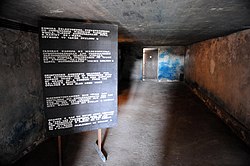Zyklon B
Zyklon B was the trade name of a pesticide invented in Germany in the early 1920s. It contains hydrogen cyanide as well as other chemicals.
The product was used in Nazi Germany in gas chambers to kill Jews as part of the Holocaust, such as at Auschwitz and other extermination camps.
Hydrogen cyanide, present in Zyklon B, is a poisonous gas that interferes with respiration in cells. The cyanide ion stops the cell from making ATP by binding into a protein involved in the reaction.
History
Hydrogen cyanide had been discovered in the late 18th century and was usually used in California for the fumigation of citrus trees. In 1919, the Deutsche Gesellschaft für Schädlingsbekämpfung mbH (Degesch) was founded in Germany. This was a state-controlled group to investigate military uses of the chemical. The new product was marketed as a pesticide, Zyklon, but was soon banned as being similar to a mixture used in World War I as a weapon.[1]
Zyklon B was recreated by Degesch, after Degesch came under new management, and eventually after achieving a patent, Walter Heerdt was named as its inventor.
It was used at U.S Customs facilities along the Mexican border to fumigate the clothes of border crossers.[2]
Zyklon B Media
Zyklon labels from Dachau concentration camp used as evidence at the Nuremberg trials; the first and third panels contain manufacturer information and the brand name, the center panel reads "Poison Gas! Cyanide preparation to be opened and used only by trained personnel"
A fumigation team in New Orleans, 1939. Zyklon canisters are visible.
Empty Zyklon B canisters found by the Allies at Auschwitz-Birkenau in 1945
Rudolf Höss at his trial in Poland, 1947
Interior of Majdanek gas chamber, showing Prussian blue residue




